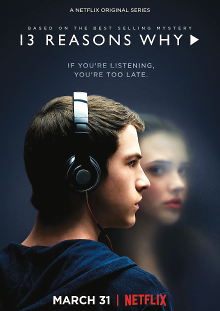Google searches using terms related to suicidal ideation rose significantly in the days following the March 31 release of “13 Reasons Why”—a Netflix series about a teenage girl who dies by suicide.
The finding was reported in a research letter published last month in JAMA Internal Medicine by researchers from multiple institutions. They found that searches using the terms “how to commit suicide,” “commit suicide,” and “how to kill yourself” were all significantly higher following the series’ release.
“13 Reasons Why” explores the suicide of a fictional teenage girl, and the final episode of the series includes a three-minute, graphic scene of her death. The series has generated widespread interest, as well as debate about its public health implications.
The researchers compared Internet searches using some 20 terms related to “suicide” in the 19 days following the release of “13 Reasons Why” (March 31 through April 18) with expected search volumes assuming the series had never been released. Statistical modeling, using daily trends from January 15 to March 30, was used to forecast expected volumes.
(The cut-off date of April 18 was chosen to avoid search results being affected by the suicide of National Football League player Aaron Hernandez on April 19.)
All suicide queries were cumulatively 19 percent higher for the 19 days following the release of “13 Reasons Why,” reflecting 900,000 to 1.5 million more searches than expected. For 12 of the 19 days studied, suicide queries were significantly greater than expected, ranging from 15 percent higher on April 15 to 44 percent higher on April 18. Searches using the terms “how to commit suicide” were 26 percent higher during this period.
Notably, searches for suicide hotlines were also elevated, including “suicide hotline number” (21 percent) and “suicide hotline” (12 percent), as were searches using the terms “suicide prevention” (23 percent) and “teen suicide” (34 percent).
“It is unclear whether any query preceded an actual suicide attempt,” John W. Ayers, Ph.D., M.A., of San Diego State University and colleagues wrote. “However, suicide search trends are correlated with actual suicides. … The deleterious effects of shows such as '13 Reasons Why' could possibly be curtailed by following the World Health Organization’s (WHO) media guidelines for preventing suicide, such as removing scenes showing suicide, or addressed by including suicide hotline numbers in each episode. These strategies could be retrofitted to the released episodes, included in the planned second season, or applied to other programs.
“Moreover, programs might undergo testing to evaluate any effect on public health outcomes before release to minimize societal harms,” Ayers and colleagues wrote.
In an editorial that accompanied the JAMA research letter, John R. Knight, M.D., of Boston Children’s Hospital and Harvard University and colleagues said it is clear that there was a strong response to “13 Reasons Why” that may encourage others to produce similar shows. “That being the case, it is imperative that producers and broadcasters demonstrate that they are ethically and socially responsible by adhering to safe messaging guidelines and by providing young viewers, and the supportive adults in their lives, with the resources necessary to process such emotionally laden content, especially given that such content is often watched over a short period of time (‘binge watching’),” they wrote. “This immersion into the story and images may have a particularly strong effect on adolescents, whose brains are still developing the ability to inhibit certain emotions, desires, and actions.”
Immediate past APA President Maria A. Oquendo, M.D., Ph.D., an internationally recognized expert on suicide, echoed those remarks. “Anything that makes anyone dying by suicide appear heroic, larger than life, or unusually sympathetic is a disservice,” she told Psychiatric News. “This is especially important for adolescents who are impressionable.”
Oquendo seconded the researchers in calling for adherence to WHO guidelines regarding publicity about suicide, especially highlighting the relationship of mental illness to suicide and the fact that mental illness is treatable.
“It is very important for parents to be talking to their kids if they are watching this show or others like it, emphasizing the relationship of suicide with mental illness, and that suicide is not a solution, but getting treatment is,” Oquendo said. ■
“Internet Searches for Suicide Following the Release of 13 Reasons Why” can be accessed
here. The WHO guidelines are available
here.

